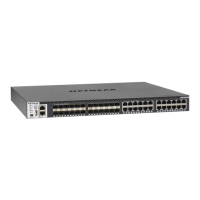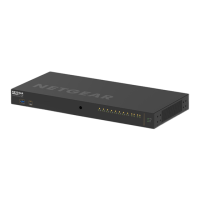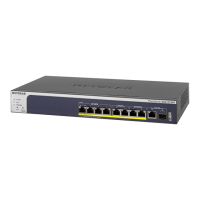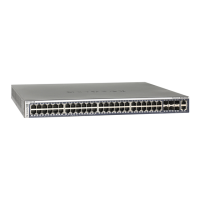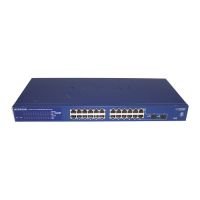OSPF and OSPFv3
385
M4300 Series and M4300-96X Fully Managed Switches User Manual
6. In the Area ID field, enter the OSPF area ID.
An area ID is a 32-bit integer in dotted-decimal format that uniquely identifies the area to
which a router interface connects.
7. In the Import Summary LSAs list, select the Enable or Disable option.
If you select Enable, summary LSAs are imported into areas.
The default is Enable.
8. In the Default Cost
field, enter the metric value to be applied for the default route advertised
into the stub area.
The valid values range from 1 to 16,777,215. This value is applicable only to stub areas.
9. Click the Add button.
The area is configured as a stub area.
10. Click the Apply button.
Your settings are saved.
The following table describes the nonconfigurable information that is displayed.
Configure the OSPFv3 NSSA Area
To configure the OSPFv3 NSSA area:
1. Launch a web browser.
2. In the address field of your web browser, enter the IP address of the switch.
The login window opens.
3. Enter the user name and password.
The default admin user name is
admin and the default admin password is blank, that is,
do not enter a password.
Table 140. Advanced OSPFv3 Stub Area Configuration
Field Description
SPF Runs The number of times that the intra-area route table was calculated using
this area's link state database. This is done using Dijkstra's algorithm.
Area Border Router Count The total number of area border routers reachable within this area.
This
is initially zero, and is calculated in each SPF Pass.
Area LSA Count The total number of link state advertisements in this area's link state
database, excluding
AS External LSAs.
Area LSA Checksum The 32-bit unsigned sum of the link state advertisements' LSA
checksums contained in this area's link state database. This sum
excludes external (LSA type 5) link state advertisements.
The sum can
be used to determine if there was a change in a router's link state
database, and to compare the link state database of two routers.
Type of Service This field is the normal ToS associated with the stub metric.

